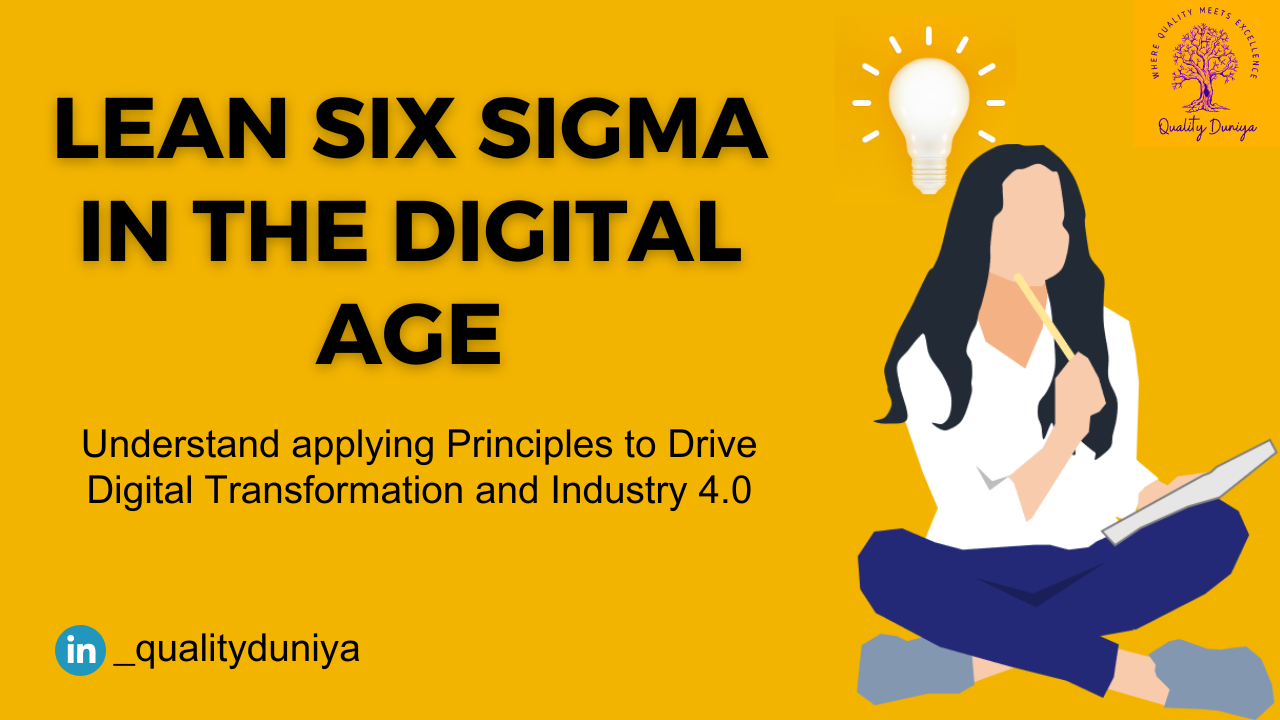Lean Six Sigma in the Digital Age: In today's rapidly evolving digital landscape, businesses face the challenge of keeping up with technological advancements while maintaining efficiency and quality in their operations. This is where Lean Six Sigma, a renowned methodology for process improvement, plays a crucial role.
In
this blog, we will explore how the principles of Lean Six Sigma are being
applied in the context of digital transformation and Industry 4.0,
revolutionizing the way organizations operate and excel in the digital age.
What is Lean Six Sigma
Lean Six Sigma is a powerful methodology that combines the
concepts of Lean Manufacturing and Six Sigma, aiming to reduce waste, improve
efficiency, and enhance quality. Lean principles focus on eliminating
non-value-added activities, while Six Sigma principles aim to minimize process
variations and defects. The integration of these two approaches creates a
comprehensive framework that helps businesses achieve operational excellence.
Digital Transformation and Industry 4.0
Digital transformation refers to the integration of digital
technologies into various aspects of a business, fundamentally changing how
organizations operate, deliver value, and interact with customers. Industry
4.0, often referred to as the fourth industrial revolution, represents the era
of automation, data exchange, and artificial intelligence in manufacturing and
other industries. Lean Six Sigma principles can be effectively leveraged to
drive digital transformation and succeed in the Industry 4.0 landscape.
Applications of Lean Six Sigma in the Digital Age
Process Optimization:
Lean Six Sigma provides a structured
approach to analyzing and optimizing digital processes, ensuring maximum efficiency
and effectiveness. By identifying and eliminating bottlenecks, redundancies,
and non-value-added activities in digital workflows, organizations can
streamline their operations and improve overall productivity.
Data-Driven Decision-Making:
In the digital age,
organizations have access to vast amounts of data. Lean Six Sigma encourages
data-driven decision-making by using statistical tools and techniques to
analyze data and identify improvement opportunities. By making informed
decisions based on data insights, businesses can drive continuous improvement
and achieve better outcomes.
Customer-Centricity:
Lean Six Sigma emphasizes the
importance of understanding and meeting customer needs. In the digital age,
customer expectations have evolved, and organizations must adapt accordingly.
By using Lean Six Sigma methodologies, businesses can map customer journeys,
identify pain points, and develop innovative digital solutions that enhance the
customer experience.
Agile Implementation:
Digital transformation initiatives
often require organizations to adopt agile methodologies. Lean Six Sigma
provides a solid foundation for agile implementation by promoting iterative
improvement, continuous learning, and adaptability. This enables organizations
to respond quickly to changing market demands and stay ahead in the digital
landscape.
Benefits of Applying Lean Six Sigma in the Digital Age
Enhanced Efficiency:
By eliminating waste and optimizing
digital processes, organizations can achieve higher levels of efficiency,
leading to cost savings and improved productivity.
Improved Quality:
Lean Six Sigma principles focus on
minimizing defects and variations. By applying these principles to digital
processes, businesses can enhance the quality of their digital products,
services, and customer interactions.
Increased Customer Satisfaction:
Through the
customer-centric approach of Lean Six Sigma, organizations can deliver digital
solutions that meet and exceed customer expectations, leading to higher
satisfaction levels and increased customer loyalty.
Competitive Advantage:
Implementing Lean Six Sigma
methodologies in the digital age allows organizations to stay ahead of the
competition. By continuously improving processes, leveraging data insights, and
embracing digital transformation, businesses can position themselves as
industry leaders in the digital landscape.
Conclusion
In the era of digital transformation and Industry 4.0, Lean Six Sigma provides a powerful framework for organizations to excel. By applying Lean Six Sigma principles, businesses can optimize their digital processes, make data-driven decisions, enhance the customer experience, and gain a competitive edge. Embracing Lean Six Sigma in the digital age.







